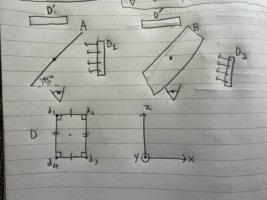MathWizard2
New member
- Joined
- Oct 26, 2021
- Messages
- 1
I need help with this Linear Algebra problem related to optics.
Please see the attached diagram for reference. Consider first the plane mirror A, which is centered at the origin in the given coordinate system and makes a 45º angle with both the XY and ZY planes. An eyeball (E) is located somewhere on the negative z-axis and a planar, rectangular display D1 has its center on the positive x-axis and is parallel to the ZY plane (see diagram). When light from display D1 is reflected off of mirror A, eyeball E sees virtual image D', which is parallel to the XY plane and has its center on the positive z-axis (again, see diagram). Now, consider plane mirror B, which is just plane mirror A rotated 10º about the x-axis (the direction of rotation doesn't actually matter so long as you are consistent). Your task is to find display D2 such that the virtual image formed by plane mirror B is still D'. Specifically, you need to find:

Thank you!
Please see the attached diagram for reference. Consider first the plane mirror A, which is centered at the origin in the given coordinate system and makes a 45º angle with both the XY and ZY planes. An eyeball (E) is located somewhere on the negative z-axis and a planar, rectangular display D1 has its center on the positive x-axis and is parallel to the ZY plane (see diagram). When light from display D1 is reflected off of mirror A, eyeball E sees virtual image D', which is parallel to the XY plane and has its center on the positive z-axis (again, see diagram). Now, consider plane mirror B, which is just plane mirror A rotated 10º about the x-axis (the direction of rotation doesn't actually matter so long as you are consistent). Your task is to find display D2 such that the virtual image formed by plane mirror B is still D'. Specifically, you need to find:
- An equation for the line L2 containing the origin and the center of D2
- The plane containing D2 (note that this is likely, NOT perpendicular to L2)
- The coordinates for the corners of D2 such that D' appears as a vertical rectangle to the user (i.e. how D2 must be rotated about L2 to create that effect).

Thank you!
